Cook Crew – Assigned 754th Squadron – June 25, 1944
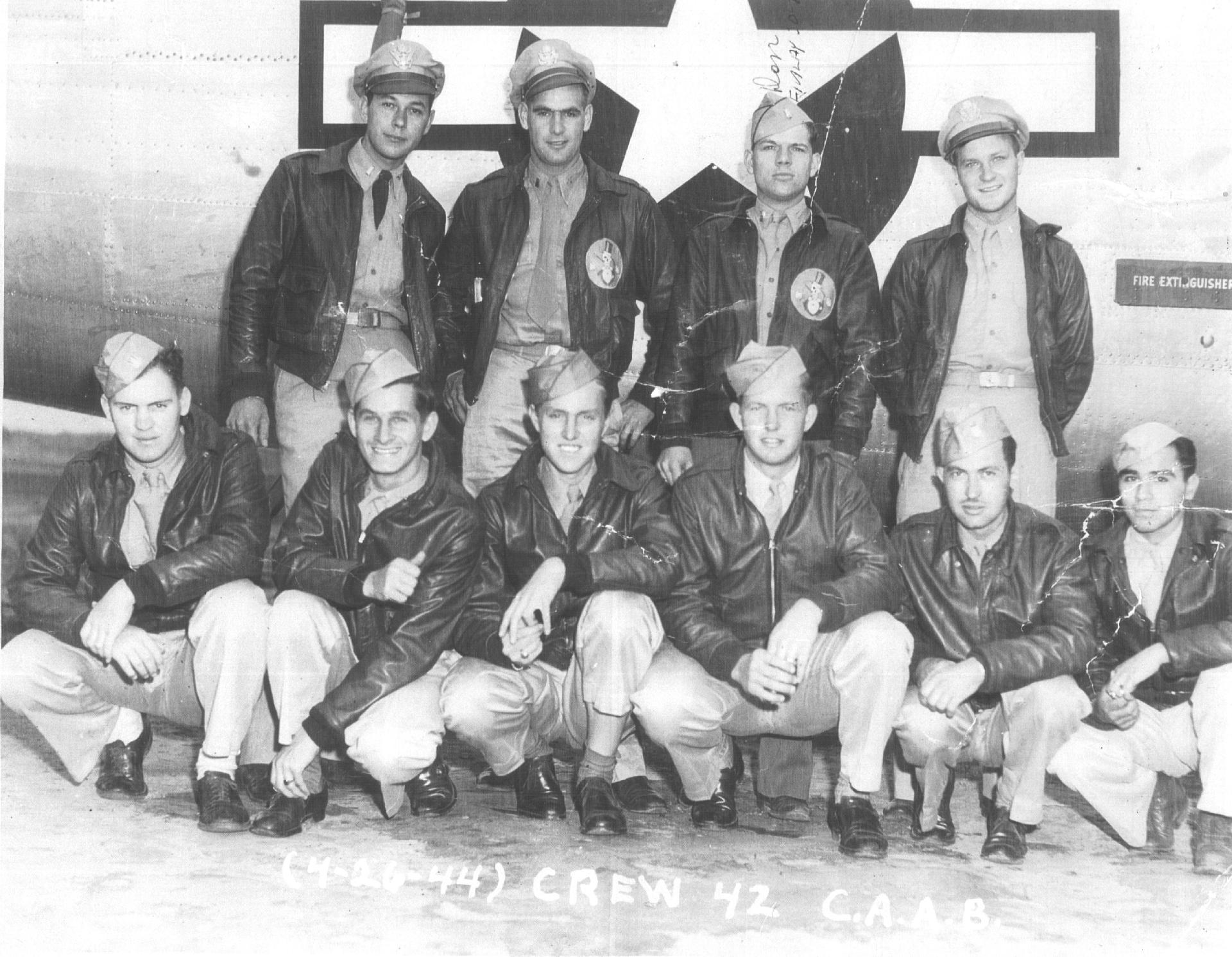
Completed Tour
| Rank | Name | Serial # | Crew Position | Date | Status | Comments |
|---|---|---|---|---|---|---|
| Capt | Warren G Cook | 696436 | Pilot | 4-May-45 | CT | Sqdn Asst Ops Officer |
| 1Lt | George A Grodt | 820738 | Co-pilot | 14-Nov-44 | CT | Award - Distinguished Flying Cross |
| 1Lt | Donald E Finlayson | 707251 | Navigator | 14-Nov-44 | CT | Award - Air Medal (OLC) |
| 1Lt | James T Bradley | T124389 | Bombardier | 31-May-45 | CT | Award - Distinguished Flying Cross |
| T/Sgt | Raymond J Metz | 36588939 | Radio Operator | 2-Jan-45 | CT | Award - Air Medal (OLC) |
| T/Sgt | Maurice M Summerall | 3454593 | Flight Engineer | 14-Nov-44 | CT | Award - Distinguished Flying Cross |
| S/Sgt | Henry Arias | 32622421 | Aerial Gunner | 14-Nov-44 | CT | Award - Distinguished Flying Cross |
| S/Sgt | Jesse E Boston | 39129674 | Armorer-Gunner | 14-Nov-44 | CT | Award - Distinguished Flying Cross |
| S/Sgt | Charles R Ferrell | 36574124 | Aerial Gunner | 14-Nov-44 | CT | Award - Distinguished Flying Cross |
| S/Sgt | Walter M Austin, Jr | 34828330 | Aerial Gunner | 14-Nov-44 | CT | Award - Distinguished Flying Cross |
Warren cook and crew arrived at Horsham St Faith in late June 1944, and were assigned to the 754th Squadron. The crew flew their first mission on July 6th. Throughout July the crew flew eight additional missions, although on three of these the crew were forced to abort. In August the crew flew a total of 13 credited missions. In September the 458BG came off of combat operations in order to fly gasoline to Patton’s Army in France. Cook and several members of the crew took part in nine of these cargo flights, dubbed “Truckin’ Missions”, for which they received no sortie credit as these were not deemed combat missions.
The crew completed their required number of missions in December 1944. Cook flew his last on December 10th, but was tasked on Christmas Day to fly the assembly ship for that day’s mission.
Lt James Bradley, the crew’s bombardier, is shown being transferred “indefinitely” to the 466BG on August 19, 1944. He returned to the 458BG at some point during September 1944, as he is shown flying with Cook on several crew load lists, but for the most part, Cook was assigned another bombardier or did not carry one after Bradley’s transfer. He was transferred to the 755BS on February 28, 1945.
All crew members except the navigator, Lt Don Finlayson, received the Distinguished Flying Cross for completing their combat tour in December. The reasons for Finalyson’s exception are below.
Missions
| Date | Target | 458th Msn | Pilot Msn | Serial | RCL | Sqdn | A/C Msn | A/C Name | Comments |
|---|---|---|---|---|---|---|---|---|---|
| 06-Jul-44 | KIEL | 85 | 1 | 42-52457 | Q | 7V | 37 | FINAL APPROACH | |
| 07-Jul-44 | LUTZKENDORF | 86 | 2 | 42-95163 | K | Z5 | 24 | DIXIE BELLE | |
| 08-Jul-44 | ANIZY, FRANCE | 87 | 3 | 42-100431 | B | J4 | 26 | BOMB-AH-DEAR | |
| 11-Jul-44 | MUNICH | 88 | 4 | 42-95108 | M | Z5 | 20 | ENVY OF 'EM ALL II | |
| 13-Jul-44 | SAARBRUCKEN | 90 | ABT | 41-28705 | W | Z5 | -- | YE OLDE HELLGATE | ABORT - LOST FORM |
| 16-Jul-44 | SAARBRUCKEN | 91 | 5 | 41-29305 | N | Z5 | 29 | I'LL BE BACK/HYPOCHONDRIAC | |
| 21-Jul-44 | MUNICH | 96 | ABT | 42-95018 | J | Z5 | -- | OLD DOC'S YACHT | ABORT - TRIM TABS |
| 25-Jul-44 | ST. LO AREA "B" | 98 | 6 | 42-95018 | J | Z5 | 28 | OLD DOC'S YACHT | |
| 28-Jul-44 | LEIPHEIM & CREEL | SCR | -- | 42-95018 | J | Z5 | -- | OLD DOC'S YACHT | BRIEFED/SCRUBBED |
| 31-Jul-44 | LUDWIGSHAFEN | 99 | ABT | 42-52441 | I | J3 | -- | LAST CARD LOUIE | ABORT - SPARE LATE T/O |
| 01-Aug-44 | T.O.s FRANCE | 100 | 7 | 42-95018 | J | Z5 | 30 | OLD DOC'S YACHT | |
| 02-Aug-44 | 3 NO BALLS | 101 | 8 | 41-29305 | N | Z5 | 33 | I'LL BE BACK/HYPOCHONDRIAC | |
| 05-Aug-44 | BRUNSWICK | 105 | 9 | 44-40287 | J | J4 | 10 | BACHELOR'S BEDLAM | COMPOSITE w/466 |
| 06-Aug-44 | HAMBURG | 106 | 10 | 41-29596 | R | Z5 | 38 | HELL'S ANGEL'S | |
| 07-Aug-44 | GHENT | 107 | 11 | 42-110070 | E | Z5 | 25 | ELMER | |
| 08-Aug-44 | CLASTRES | 108 | 12 | 42-95163 | K | Z5 | 37 | DIXIE BELLE | |
| 11-Aug-44 | STRASBOURG | 110 | 13 | 41-29596 | R | Z5 | 41 | HELL'S ANGEL'S | |
| 12-Aug-44 | MOURMELON | 111 | 14 | 41-29596 | R | Z5 | 42 | HELL'S ANGEL'S | |
| 13-Aug-44 | LIEUREY | 112 | 15 | 41-29596 | R | Z5 | 43 | HELL'S ANGEL'S | |
| 15-Aug-44 | VECHTA | 114 | 16 | 42-51110 | P | Z5 | 34 | TOP O' THE MARK | |
| 16-Aug-44 | MAGDEBURG | 115 | ABT | 41-28709 | I | 7V | -- | LUCKY STRIKE | ABORT - LOST FORM |
| 18-Aug-44 | WOIPPY | 116 | 17 | 42-95165 | S | Z5 | 30 | COOKIE | |
| 26-Aug-44 | DULMEN | 120 | 18 | 41-29596 | R | Z5 | 49 | HELL'S ANGEL'S | |
| 27-Aug-44 | FINOW | 121 | 19 | 41-29596 | R | Z5 | 50 | HELL'S ANGEL'S | MISSION CRED NOV |
| 09-Sep-44 | MAINZ | 124 | 20 | 44-40287 | J | J4 | 14 | BACHELOR'S BEDLAM | |
| 10-Sep-44 | ULM M/Y | 125 | 21 | 41-29596 | R | Z5 | 53 | HELL'S ANGEL'S | |
| 11-Sep-44 | MAGDEBURG | 126 | 22 | 41-29596 | R | Z5 | 54 | HELL'S ANGEL'S | |
| 21-Sep-44 | HSF to LILLE | TR05 | -- | 42-95108 | M | Z5 | T4 | ENVY OF 'EM ALL II | CARGO |
| 23-Sep-44 | HSF to ST DIZIER | TR07 | -- | 41-28712 | D | 44BG | T4 | TUFFY | TRUCKIN' MISSION |
| 25-Sep-44 | HSF to LILLE | TR08-1 | -- | 42-110059 | T | Z5 | T1 | NO NAME or NAME UNKNOWN | 1ST FLIGHT - CARGO |
| 25-Sep-44 | HSF to LILLE | TR08-2 | -- | 42-110059 | T | Z5 | T2 | NO NAME or NAME UNKNOWN | 2ND FLIGHT - CARGO |
| 27-Sep-44 | HSF to LILLE | TR10 | -- | 42-52296 | E | T4 | NOT 458TH SHIP - HETHEL | 1ST FLIGHT | |
| 27-Sep-44 | HSF to LILLE | TR10 | -- | 42-52296 | E | T5 | NOT 458TH SHIP - HETHEL | 2ND FLIGHT | |
| 28-Sep-44 | HSF to LILLE | TR11 | -- | 42-52296 | E | T6 | NOT 458TH SHIP - HETHEL | TRUCKIN' MISSION | |
| 29-Sep-44 | HSF to LILLE | TR12 | -- | 42-95108 | M | 754 | T10 | ENVY OF 'EM ALL II | 2ND FLIGHT |
| 29-Sep-44 | HSF to LILLE | TR12 | -- | 42-52296 | E | T7 | NOT 458TH SHIP - HETHEL | 1ST FLIGHT | |
| 05-Oct-44 | PADERBORN | 128 | 23 | 41-29596 | R | Z5 | 55 | HELL'S ANGEL'S | |
| 06-Oct-44 | WENZENDORF | 129 | 24 | 41-29596 | R | Z5 | 56 | HELL'S ANGEL'S | |
| 07-Oct-44 | MAGDEBURG | 130 | 25 | 41-29596 | R | Z5 | 57 | HELL'S ANGEL'S | |
| 09-Oct-44 | KOBLENZ | 131 | 26 | 42-50456 | D | Z5 | 3 | DOROTHY KAY SPECIAL | |
| 17-Oct-44 | COLOGNE | 135 | 27 | 41-29596 | R | Z5 | 61 | HELL'S ANGEL'S | |
| 26-Oct-44 | MINDEN | 138 | 28 | 42-51196 | Q | J3 | 6 | THE GYPSY QUEEN | |
| 30-Oct-44 | HARBURG | 139 | 29 | 41-29596 | R | Z5 | 64 | HELL'S ANGEL'S | |
| 02-Nov-44 | BIELEFELD | 140 | 30 | 41-29596 | R | Z5 | 65 | HELL'S ANGEL'S | |
| 08-Nov-44 | RHEINE | 144 | 31 | 42-51179 | P | Z5 | 46 | DUSTY'S DOUBLE TROUBLE | |
| 09-Nov-44 | METZ AREA | 145 | ANA | 44-40298 | E | Z5 | 11 | THE SHACK | A/C NOT ATTKG |
| 16-Nov-44 | ESCHWEILER | 147 | 32 | 42-50456 | D | Z5 | 12 | DOROTHY KAY SPECIAL | |
| 21-Nov-44 | HARBURG | 148 | 33 | 42-110059 | T | Z5 | 46 | UNKNOWN 056 | |
| 30-Nov-44 | HOMBURG | 151 | 34 | 41-29596 | R | Z5 | -- | HELL'S ANGEL'S | LOAD LIST |
| 04-Dec-44 | BEBRA | 152 | 35 | 41-29596 | R | Z5 | 72 | HELL'S ANGEL'S | |
| 10-Dec-44 | BINGEN | 154 | 36 | 44-40126 | L | Z5 | 30 | SPITTEN KITTEN / SKY TRAMP | |
| 25-Dec-44 | PRONSFELD | 158 | ASSY | 41-28697 | Z | Z5 | A39 | SPOTTED APE | ASSEMBLY CREW |
1Lt Donald E. Finlayson – Navigator

Lt. Finlayson’s mission to Munich, July 11, 1944
Mission number four was on aircraft #108 [Envy of ’em All, II], attacking Marshalling Yards, duration 8:20 hours. You probably are aware that the 8th decided to train bombardiers (normally manning the nose turret) in navigation, for obvious reasons.
On this particular mission, Jimmie [Bradley] sat at the navigators “desk” (ha! ha!) and I got into the nose turret. As you know, “follow-aircraft” had the bombardier toggle when he sighted the lead ship drop its bombs. Having been to gunnery school in Fort Meyers, FL, between Basic Navigation School and Advanced Navigation School (both in Monroe, LA) it was assumed I knew how to fire .50 caliber machine guns. (Let alone “toggle”!!)
Well, try as I might, I could not “charge” the gun. I kept pulling back on the crank [handle] to no effect. My mind raced with the knowledge we were on a combat mission over enemy territory (might we be attacked by the Luftwaffe?) and my failure in the nose turret made me increasingly flustered, frightened, flailing, etc.
Unbeknownst to me, the hose from my oxygen mask became disconnected from the connection to the aircraft’s supply, and I passed out. Fortunately for me, Cookie just about then had a, “Is everybody all okay?” call over the intercom. No reply from the unconscious Finlayson; Jimmie hand-cranked the nose turret, pulled me from it, and applied 100% oxygen. Whether all these years since this near-death, I have been a little crazy, I leave to others to judge!!”
2Lt Don Finlayson’s mission list
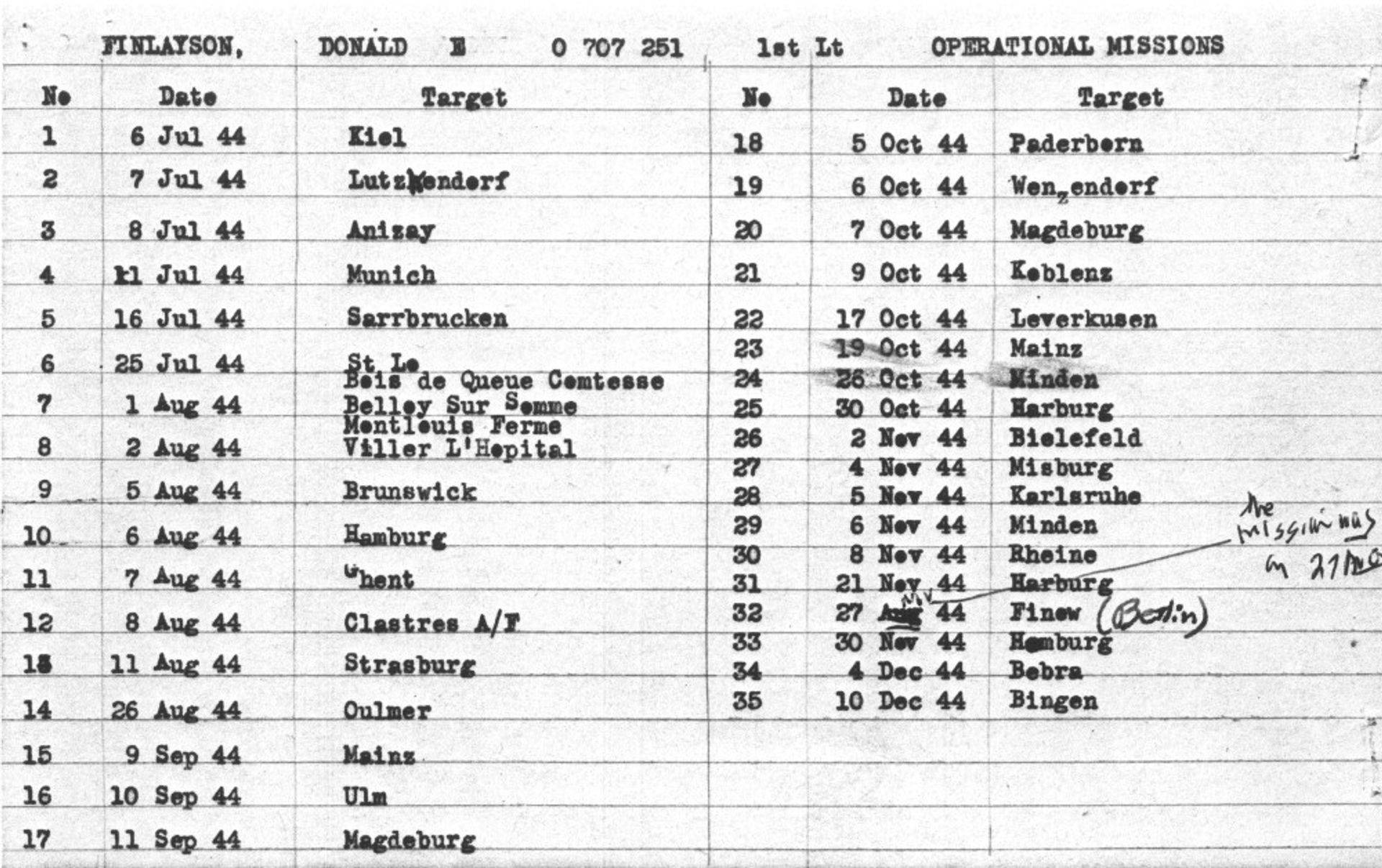
Practice Mission – No DFC
From time to time, “practice missions” were flown “over there”. This was “practice” for Pilots and Co-Pilots for formation flying. Rest of the crew pretty much slept! As I recall, we Navigators were not “briefed” as to what English airspace we would fly over (no maps, etc.) Nevertheless, the entire Crew was required to be onboard.
I do not remember the date, nor have any augmenting data, but one morning, after being awakened for the “practice mission”, this naughty boy rolled over and went back to sleep. Thereafter ensued substantial “punishment” for failing to show up for the “practice mission.” The Sq CO grounded me from all flying for two weeks (it was “fun” to be a “Barracks Inspector”…yeah, yeah) Obviously, during this two week period Cookie’s crew (with another Navigator) continued to fly “COMBAT” missions.
As the Military is so often wont to do, without any advance notice, established a new policy that X number of Combat Missions had to have been flown by such- and-such a date, for a crewman to be awarded the DFC. My “sleepiness” thus had resulted in my failing the criteria. Cookie’s entire crew, with the exception of Lt. Finlayson, was awarded the DFC. I did ask Sq CO for “help”…he said no.
[Going by the respective mission lists, this two-week period appears to have been August 12-25, 1944.]
Mission To: Kwaksan, North Korea – by Howard Whitley (B-29, 343rd)
The following was submitted by Jim Cook: My father, Warren G. Cook, was the pilot of Miss Tampa X during the Korean War. The plane flew 144 missions, a record among B-29s flying from his base. He also flew 36 missions over Germany in B-24s, and went on to fly B-47s and B-52s, retiring in 1966 after 24 years of service. He was awarded the Distinguised Flying Cross with Oak Leaf Cluster and the Air Medal with 4 clusters. He died in 1994. We miss him.
—————————————–
The following article originally appeared on pages 11-13 of The Pyramidiers, the newsletter of the 98th Bomb Group/Wing Veterans Association, in August of 2011. Permission to reprint it on the KWE was granted by Herb Harper, the 98th Historian. All credit for the article goes to Howard Whitley and The Pyramidiers.
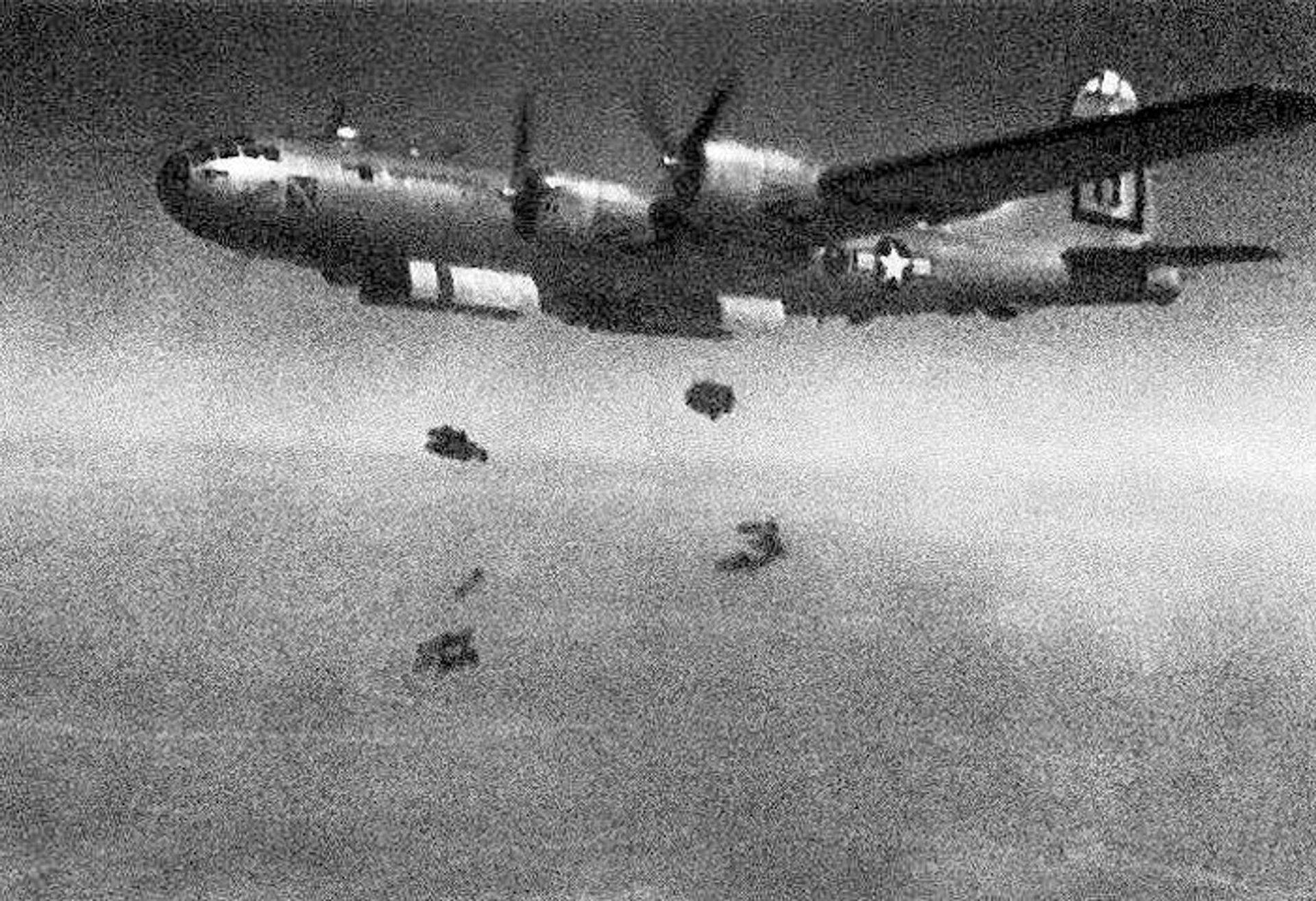
The mission was planned in order to bomb the rail bridges at Kwaksan, North Korea on June 1, 1951. Things went wrong on that bright sunny morning. There was a malfunction on our first bomb run. We had to go around and were on our second run when the F-86s left us. To the best of my knowledge there was no engagement between F-86s and MiG-15s that morning. I was sitting in the tunnel watching the MiG formations out of the blister (plexiglass). They looked ghostly white against a blue sky. I watched the first MiG strike, then scampered down to my radio position, grabbed my flak suit and helmet and hunkered on the floor.
Captain Cook had already made the decision to close the bomb bay doors and make a run for it. We were at the mercy of thirty MiGs. All I could do was listen on the intercom to the gunners’ calls and empty shells falling into the turret from our four 50 caliber machine guns above my head. The tail guns were knocked out on the first pass. It seemed like this battle would never end. Finally, it was over and the tail gunner position had taken a direct shell hit. Thankfully the gunner was not wounded.
The A/C, Aircraft Commander told me to get off an S.O.S. “We’re hit in the wing tank, on fire. Do not know the extent of damage. Will try to make South Korea.” We were sprinkled with flak somewhere along the route, but no major damage. We had taken three shell hits: in the tail, in the fuselage behind the left gunner (hence the fire in the radar compartment) and in the wing between the Number 1 and Number 2 engines.
God bless the Marine Corps! They came up in a plane and looked us over. They said the fire was out and we looked fine, except our bomb bay doors were hanging open. We got to an airfield and told the tower we’d like to land except that we might bum on the way in. The crew was given a choice again of bailing out or riding the plane down. One of the crew said, “Hell, we’ve come this far. We’ve got faith. Let’s go in. We made a normal landing. Only one of the four B-29 bombers was lost. I don’t know why we didn’t blow up. Three MiG shells had hit us. You could look in the hole in the wing and could see gasoline. You could reach right in and grab a handful. But if one is really trying there are times when there is always a way out of these types of situations.
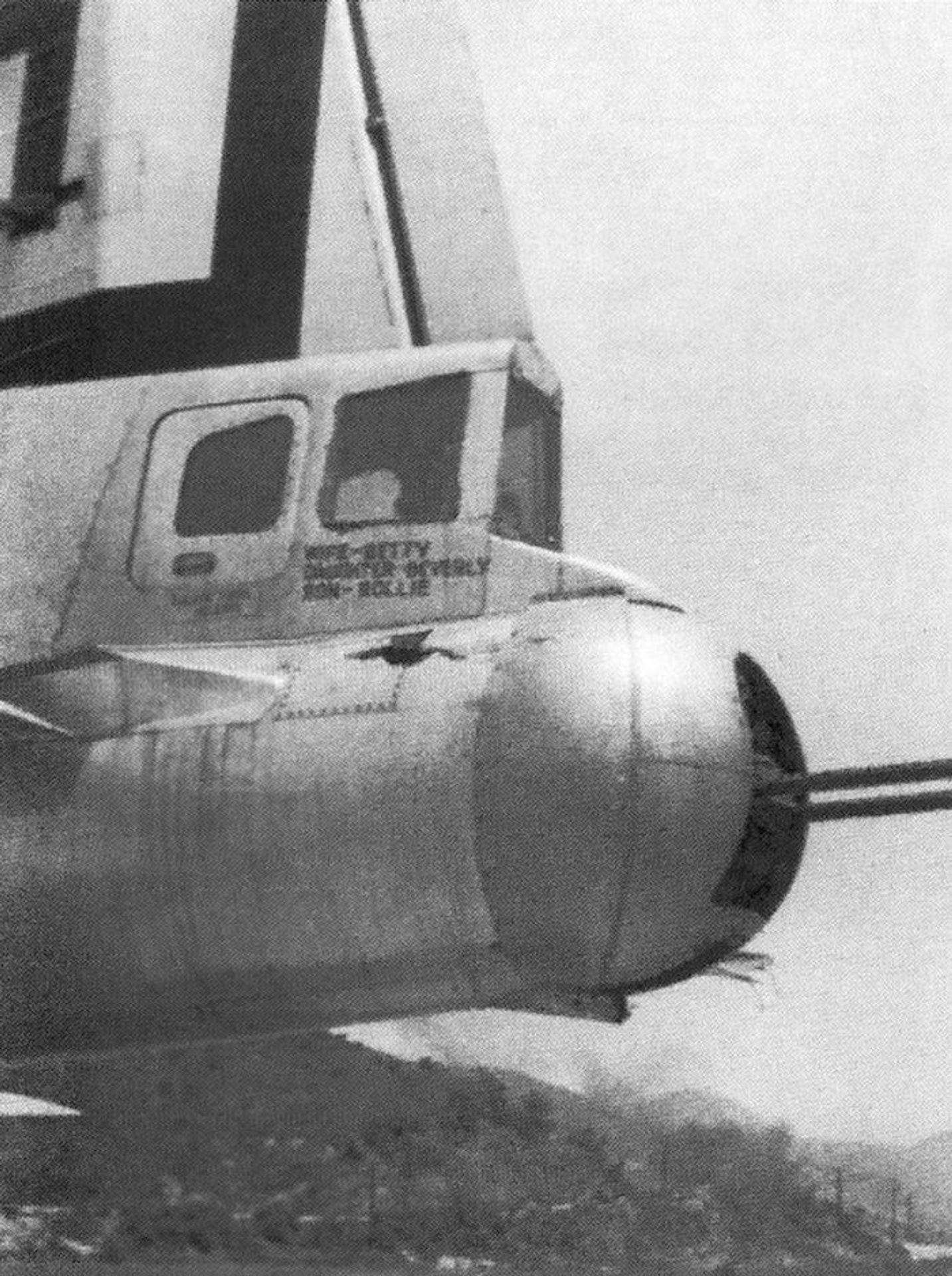
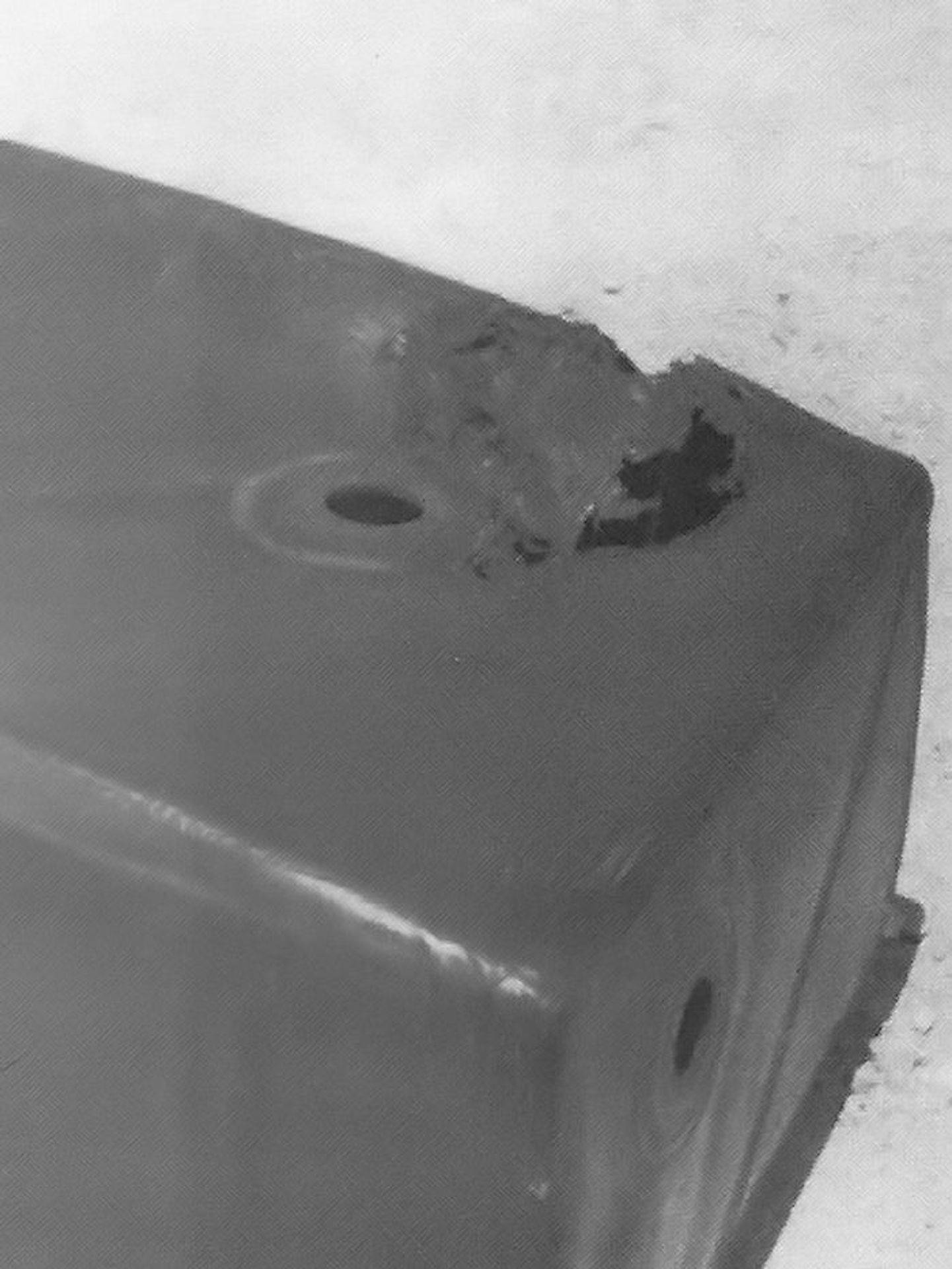
MiG-15 Attack: Shell hole from MiG 15, knocking out guns; and wing tank damage, Pusan AFB, South Korea
We dropped our bombs on Sariwon probably at the lowest altitude we had ever dropped. A 1000 pound bomb stayed on the front bomb bay shackle. I told the A/C. The bombardier tried to salvo. It was a no go. The A/C said to close the bomb bay doors and take the bomb with us. About 10 minutes later there was a loud boom. Sunlight hit me in the face through the bulkhead doors. For an instant, I thought the bomb had exploded. The bomb had fallen free and buckled the doors so badly they wouldn’t close. Gunners said they saw it explode on a mountain top below.
All four B-29s in our group were damaged. One went down, one went back to Yokota, one went to Kimpo or Taegu and we landed at Pusan. The A/C told us to get out fast after landing as there was concern a live shell might still be in the plane. No nose wheel exit for me as I went out the front bomb bay and ran. No shell was found.
We flew back to Tachikawa AFB that night on a NAT C-54 and took a bus to Yokota AFB arriving at 3:00 a.m. Our tent was the center of attention that morning. It seemed like every 343rd flight crew descended on our tent in jubilation. We were told that they heard we were shot down. Our missions dwindled after that. When our plane was brought back from Pusan it was never the same. TDY Widow #6335 was a damaged lady.

TDY Widow on tarmac at Yokota AB, Japan
Captain Warren Cook as A/C came to Yokota early in 1951 from Travis AFB to replace Major Edward Dickinson who was transferred to operations. The crew that went down this June 1st, 1951 was Captain Cook’s old crew from Travis AFB with a new A/C. Our crew was designated to pack up their belongings for shipment to their home. They were our next door tent neighbors. This same crew of TDY Widow #6335 with Captain Warren Cook as A/C led four B-29s in a flyover for General Douglas MacArthur on April 15, 1951 when he was leaving Haneda Airport in Tokyo. Colonel David Wade, 98th Bomb Group Commander, was onboard that day. The only reference to this flyover that I can find is in the paperback, MacArthur’s War: Korea and the Undoing of an American Hero by Stanley Weintraub (page 354).
Captain Cook and his crew flew both aircraft on different missions. Thus I have attached pictures of Miss Tampa and TDY Widow with its crew members.
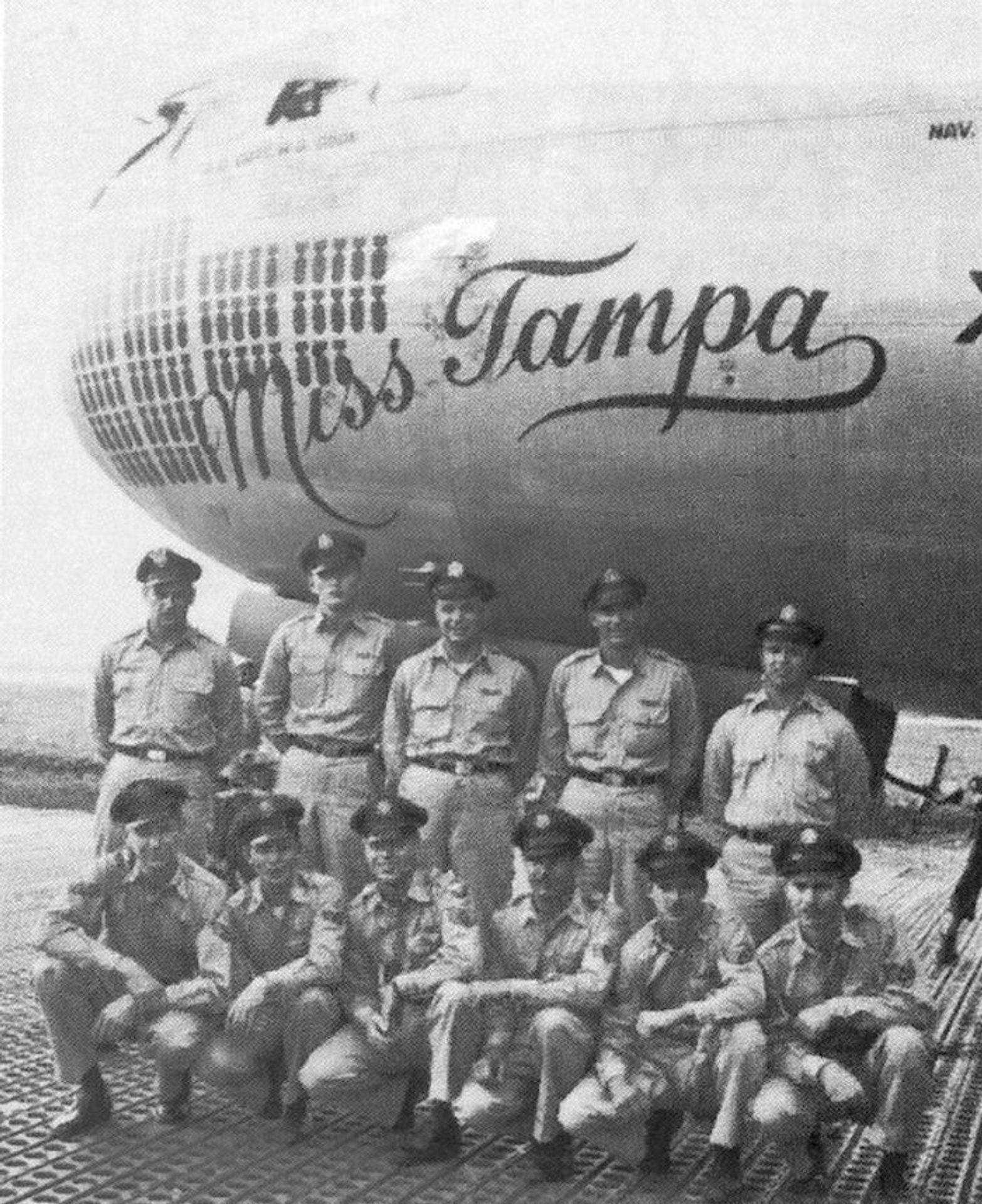
Warren Cook’s A2 Jacket
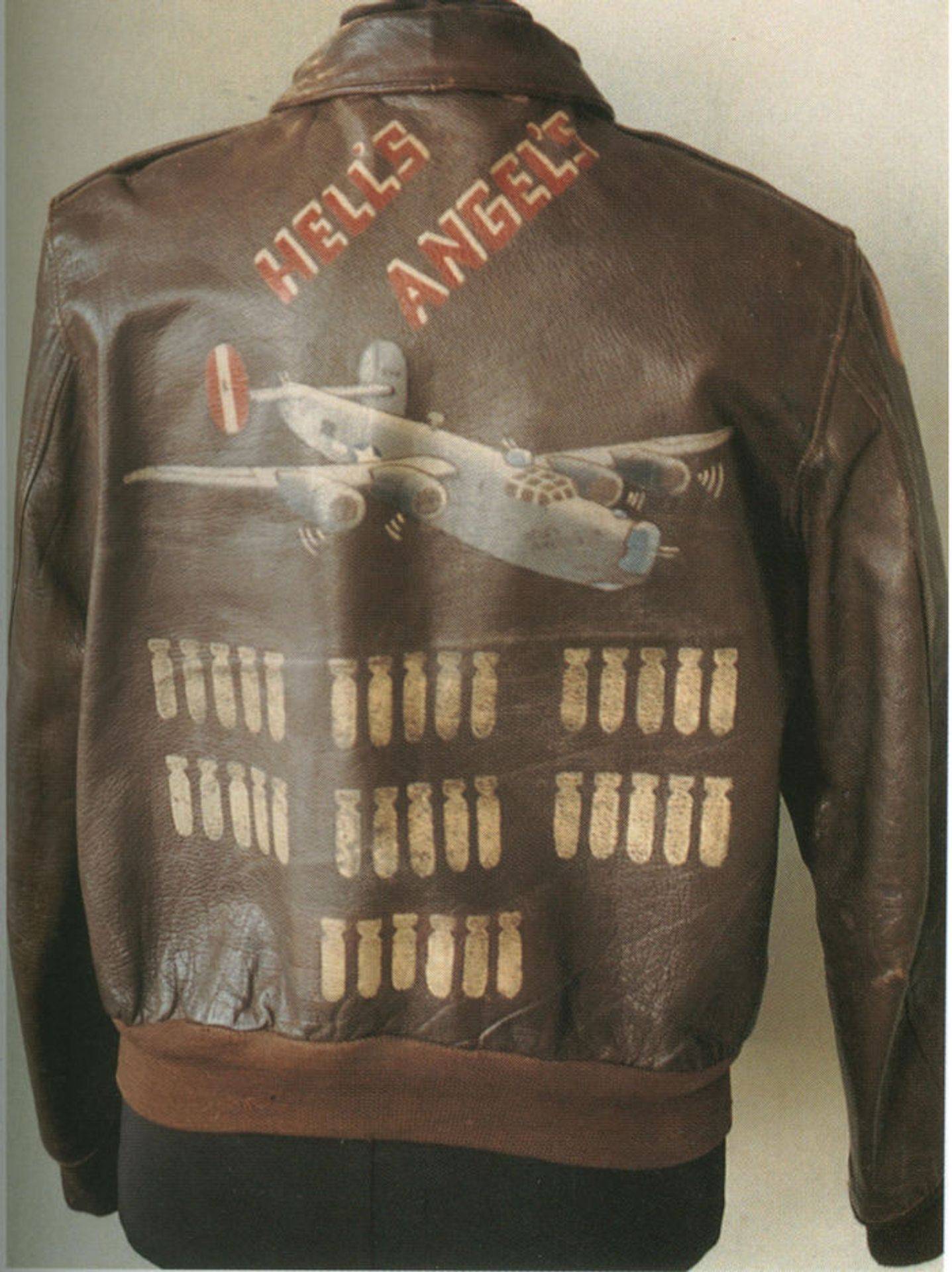
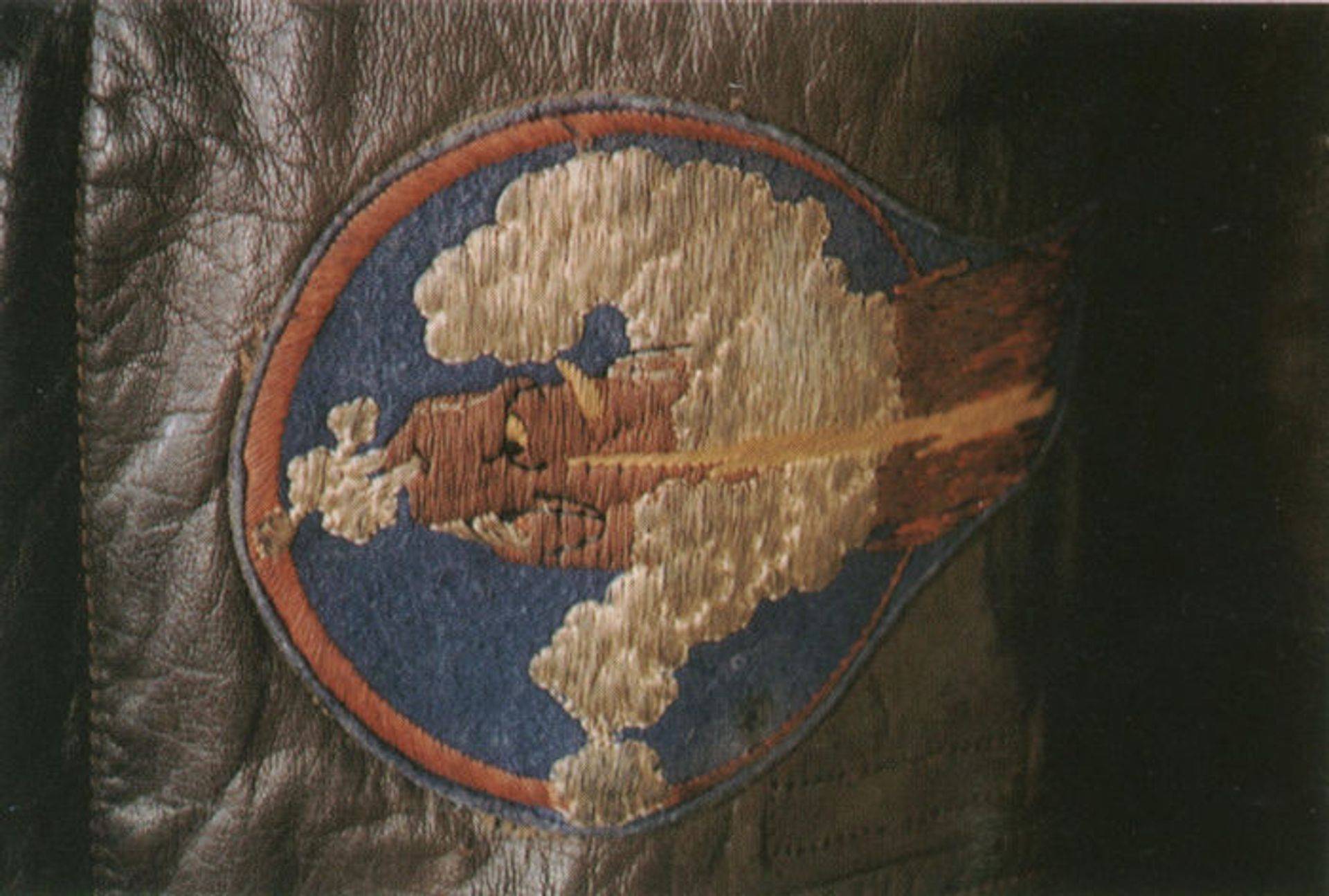
Warren Cook’s A2 jacket depicts B-24H-15-CF 41-29596 Z5 R Hell’s Angels, a B-24 that he flew on 16 of his 35 missions. This aircraft was on its 87th mission in February 1945, when it was involved in a collision with another 458BG aircraft returning from a mission.
